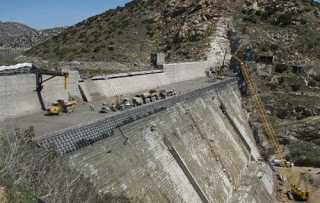Today we are going to discuss a very common, yet very important confusion that exists among fresh civil engineers that what is the different between Roller compacted concrete and conventional Reinforced Cement Concrete. So here is an answer for this;
What is Reinforced Cement Concrete?
Reinforced concrete (RC) is a composite material in which concrete\’s relatively low tensile strength and ductility are counteracted by the inclusion of reinforcement having higher tensile strength and/or ductility. The reinforcement is usually, though not necessarily, steel reinforcing bars (rebar) and is usually embedded passively in the concrete before the concrete sets.
Reinforcing schemes are generally designed to resist tensile stresses in particular regions of the concrete that might cause unacceptable cracking and/or structural failure. Modern reinforced concrete can contain varied reinforcing materials made of steel, polymers or alternate composite material in conjunction with rebar or not.
Reinforced concrete may also be permanently stressed (in compression), so as to improve the behavior of the final structure under working loads. In the United States, the most common methods of doing this are known as pre-tensioning and post-tensioning.
Many different types of structures and components of structures can be built using reinforced concrete including slabs, walls, beams, columns, foundations, frames and more.
What is Roller Compacted Concrete?
Roller-compacted concrete has the same basic ingredient as conventional concrete: cement, water, and aggregates, such as gravel or crushed stone.
But unlike conventional concrete, it\’s a drier mix—stiff enough to be compacted by vibratory rollers. Typically, RCC is constructed without joints. It needs neither forms nor finishing, nor does it contain dowels or steel reinforcing.
Like Us on Facebook!
What is the difference between Roller Compacted Concrete and Conventional Concrete?
These characteristics make roller-compacted concrete simple, fast, and economical.
These qualities have taken roller-compacted concrete from specialized applications to mainstream pavement. Today, RCC is used for any type of industrial or heavy-duty pavement. The reason is simple. RCC has the strength and performance of conventional concrete with the economy and simplicity of asphalt. Coupled with long service life and minimal maintenance, RCC\’s low initial cost adds up to economy and value.
Subscribe Us on YouTube!
For dam applications, RCC sections are built lift-by-lift in successive horizontal layers resulting in a downstream slope that resembles a concrete staircase. Once a layer is placed, it can immediately support the earth-moving equipment to place the next layer. After RCC is deposited on the lift surface, small dozers typically spread it in one-foot-thick (300mm) layers.




















This comment has been removed by a blog administrator.
This comment has been removed by a blog administrator.
This comment has been removed by a blog administrator.
This comment has been removed by a blog administrator.